#Post Roman Britain
Explore tagged Tumblr posts
Text
Time Travel Question 34: Medievalish and Earlier 3
These Questions are the result of suggestions from the previous iteration.
This category may include suggestions made too late to fall into the correct earlier time grouping. Basically, I'd already moved on to human history, but I'd periodically get a pre-homin suggestion, hence the occasional random item waaay out of it's time period, rather than reopen the category.
In some cases a culture lasted a really long time and I grouped them by whether it was likely the later or earlier grouping made the most sense with the information I had. (Invention ofs tend to fall in an earlier grouping if it's still open. Ones that imply height of or just before something tend to get grouped later, but not always. Sometimes I'll split two different things from the same culture into different polls because they involve separate research goals or the like).
Please add new suggestions below if you have them for future consideration. All cultures and time periods welcome.
#Old English#Middle English#Linguistics#Vikings#North American History#Time Travel#Early Middle Ages#Indigenous History#Prester John#Middle Ages#Koran#Greenland#King Olaf#Arthuriana#Post Roman Britain#Heian Era Japan#Japanese History#Rapa Nui#Ammonites
139 notes
·
View notes
Text
Something something the poetic irony that England - one of the Roman Empire’s least loved, bastard sons - would someday grow into the personification with the strongest claim of them all to being Rome’s heir.
Taking up his loathed and lamented conqueror/father’s doctrine of Pax, and even donning a red coat to replace the old scarlet cape once worn by Rome. When the ancient empire walked and ground the world down under his heel, so very long ago
#hetalia#hws england#hws roman empire#aph england#aph roman empire#my posts#i feel a little poetic today#don’tcha know#and britain was considered such a backwater by rome dear god#pax roma to pax britannica?#it would be the equivalent of someone telling your local crime boss#that someday he’ll be replaced by the bum who wears a plastic bag and talks to birds#i say with great affection to my rainy homeland lmao
74 notes
·
View notes
Text
does anyone want to hear about my extremely self indulgent and specific codywan medieval au?
#*medieval meaning. like 5th C (ish) britain (like just post roman/early anglo saxon)#bc it’s my favourite period <3#i’m not normally an au person really. but sometimes you spend so long researching a specific thing that you go. what if the blorbos ?#this isn’t actually a question btw. i will expand on this tomorrow bc right now i’m (in theory) going to bed. but i was thinking about them!#so i guess this is forewarning#ally natters
38 notes
·
View notes
Note
What’s your opinions on other nations?

Germania: Grandpa says Germania was always so smug as a kid, though I can't see it much
Grandpa Rome: I miss him so much. . . Grandpa was a strong country, I wish he stayed with us longer.
And Mister China doesn't seem to taking the news about the Empire's fall good either

Japan: He's a very private person, though I do wish we'd get to work together someday ^_^
Greece: Him and his mom are both like cats, always sleepy. Though I loved his plays and mythology

England: Always flustered around Big brother France, I'm not sure if they're enemies or are they married

Holy Roman Empire: It's so cute when Holy Rome tries to paint too, I still have his rabbit painting hidden away in my room
I miss him too
#aph chibitalia#aph italy#hetalia#aph rome#Implied Romechu#(OOC: I am so sorry I can't help make the ww2 joke)#aph germania#aph england#aph britain#rp ask blog#hetalia axis powers#hetalia ask blog#chibitalia#hetalia roleplay#aph Greece#aph japan#aph holy roman empire#aph hre#Original post
39 notes
·
View notes
Text

Bless the young man who hiked 3 hours to plant a new sycamore tree
#Hadrian's Wall#Northumberland#sycamore gap#twitter post#English countryside#Roman Britain#vandalism#British history#empathy#justice#sapling#rural landscape#felled tree#UK
119 notes
·
View notes
Note
WIP guessing game: fire, foe, and fun!
eagle of the ninth temeraire au:
He remembered dragon-warmth, of the little couriers of the garrison at Isca Dumnoniorum, of his father’s dragon’s scales nearly steaming at a touch, like the hypocaust sunk beneath the baths. Esca, too, was warm, but only to the degree that a man was warm — no great fire banked itself behind Esca’s ribs. Still, Marcus pressed himself tight against Esca’s chest, and tried to push away the cold.
no instances for foe, and only sort of one for fun...
unnamed lurking sharpe story:
“He said it’d be all right ‘less it starts turning funny colors… it isn’t doing that, is it?” asked Perkins, fear suddenly creeping into his voice. “Dunno, sarge — would this be a funny color to you?” Cooper pointed, and Harper leaned down obligingly and screwed up his face in disgust.
#em writes stuff#em is posting about temeraire#slightly belated summer of sutcliff#em is posting about sharpe#ha ha everyone to whom I said I wasn't going to write eot9 fic ever. Point and Laugh. Point and Laugh. Now I'm In The Soup.#and also have to worldbuild what dragon-human relations are like in temverse roman britain :]
11 notes
·
View notes
Text

Finally, a real medieval elephant appears! Just not where you might expect.
Katie Hemer, Hugh Willmott, Jane Evans, and Michael Buckley have shown that this ring was made from an African elephant's (genus Loxodonta's) ivory tusk in the fifth or sixth century. It was probably used as a handle on a cloth bag. It was found in a grave in Scremby, Lincolnshire (UK), where it had been buried sometime between around 450 and 550 AD.
And this wasn't the only elephant ivory to show up thousands of miles away in northern Europe: elephant ivory rings have been found in over 70 cemeteries in the area that is now England, and some have been found in the area that is now northern Germany, too. These cemeteries seem to date to the period before the 7th century.
This particular elephant may have originated in the African Rift Valley, and its ivory may have been traded from the Kingdom of Aksum to Europe. The time when it was traded coincided with the political power of the Roman Empire crumbling in western Europe and some (but not all) trade routes being disrupted. Yet the world has always been interconnected: we can't ignore the history of any region or any time.
Katie A. Hemer, Hugh Willmott, Jane E. Evans, Michael Buckley, "Ivory from early Anglo-Saxon burials in Lincolnshire – A biomolecular study", Journal of Archaeological Science: Reports, 49 (2023), 103943, ISSN 2352-409X, https://doi.org/10.1016/j.jasrep.2023.103943. Read it here.
16 notes
·
View notes
Text
thinking about them again


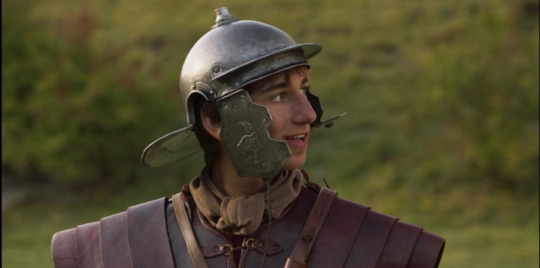




(honestly, when am I not thinking about them???)
#THE WAR IS OVER AND WE ARE BEGINNING#this song!! in our bedroom after the war by stars!! maybe it’s even more fitting for them because the war isn’t r e a l l y over#bc you don’t really get widespread lasting peace in britain for a while yet but they do because they’ve got each other <333#worlds silliest little guys (i get emotional if i think about them for too long)#horrible histories the movie#horrible histories rotten romans#orla my beloved#atti my beloved#mercury posting
7 notes
·
View notes
Text
Author: Sonja Anderson Publication: Smithsonian Magazine Timestamp: January 22, 2024
Extract:
Researchers have long been puzzled by the Roman dodecahedron. More than 100 of these strange 12-sided metal objects have been found throughout Europe—but their purpose remains unclear. Now, another discovery in England’s countryside has reignited the mystery surrounding the ancient artifacts.
[...]
“[Dodecahedrons] are one of archaeology’s great enigmas,” [Richard Parker, secretary of the Norton Disney History and Archaeology Group] says.
“Our example is remarkable. It’s in an excellent condition—considering it’s been buried for 1,700 years—and complete with no damage.["]
[...]
The hollow, grapefruit-sized object is made of copper alloy, as the Norton Disney group writes on its website. Its 12 flat sides are punctuated by circular cut-outs and studs on each corner.
According to the group, the discovery brings the number of dodecahedrons unearthed in Roman Britain to 33, while about 130 have been discovered throughout the Roman Empire’s northwest provinces. [The dodecahedron discussed in the article] stands out because it’s still in one piece, while many of the others were found fragmented or damaged.
[...]
Some Roman dodecahedrons date to as early as the first century C.E. However, no visual or textual references to the objects have been found in historical records. [...]
“Nobody knows for certain how the Romans used them,” wrote Smithsonian magazine’s Sarah Kuta last year. “Some theories are that they functioned as measuring devices, calendars, ornamental scepter toppers, weapons or tools.”
[...]
[...] the group agrees with experts who think dodecahedrons were used for ritualistic or religious purposes. [...] researchers at Belgium’s Gallo-Roman Museum have hypothesized that Romans used the objects in magical rituals, which could explain dodecahedrons’ absence from historical records: With the Roman Empire’s eventual embrace of Christianity came laws forbidding magic. Practitioners would have had to keep their rituals—and related objects—a secret.
/end of extract
"12-sided Roman relic baffles archaeologists, spawns countless theories"
Author: Leo Sands Publication: The Washington Post Timestamp: April 30, 2024 at 11:09 a.m. EDT
Extract:
“One reason that it is so captivating for the public is that it’s hard to believe that we have anything from the Roman period that we don’t know what it’s for,” Lorena Hitchens, an archaeologist specializing in Roman dodecahedrons[...] “It’s very tempting to want to solve that mystery.”
[...]
Internet sleuths have joined the speculation [...] with many gravitating toward an explanation that revolves around their use as tools. [...] knit and crochet pattern designer Amy Gaines posits [...] that dodecahedrons may have been used to knit gold chains, constructing a 3D-printed replica to demonstrate her theory.[...] English Heritage lists theories ranging from a tool for finding the best date to sow grain, to functioning as a candleholder, a polygonal die, a range finder, a surveying instrument, or a way of knitting gloves.
But academic archaeologists shy away from the suggestion that they were practical objects used as everyday tools. “I know that because I’ve examined a lot of them, and they don’t have the kind of use wear you’d expect from a tool,” Hitchens said.
“They’re also much more delicate than people realize,” she said. “They would be broken very quickly.”
[...]
The most popular theory among academic experts [...] is that dodecahedrons held religious or ritual meaning, linked in some way to local practices on the Roman Empire’s fringes.
Proponents of this theory [...] point to the intricacy of the object itself, suggesting it probably had special value. According to Hitchens, the relic was made using a lost-wax bronze-casting process, an extremely technical feat — made even more challenging by the fact that the final product was hollow. [...]
/end of extract
#Smithsonian#Washington Post#archaeology#archaeological discoveries#ancient rome#roman britain#roman dodecahedron#dodecahedron#ancient artifact#academic theories#Norton Disney History and Archaeology Group#Roman Empire#ritualistic#no consensus as of yet#antiquity#ancient artefacts#ancient artifacts#roman empire#archaeological news#field archaeology#article#articles
2 notes
·
View notes
Text
Tevinter is so Roman it's wild. Like I would bet money that someone on the staff had experience in classical studies or at least took a class at some point when they were writing the conversations you can have with Dorian.
#sorry I know I make a post like this every time I replay dai but it really is just like flashbacks to my roman history class#like yeah sure there are the big things like empire that killed fantasy jesus and left ruins all over fantasy britain and france etc etc#but it's the little details that get me. like the nobles being descended from dreamers who could communicate with the old gods#or magisters adopting their successors
0 notes
Text

Northern Britain: Coel Hen is a familiar figure in many ancient Welsh genealogies, with most of the kings of the north of Britain being able to trace their descent from him.
#historyfiles#history#Post-Roman#Romano-Britons#britain#ancient welsh#welsh#Coel Hen#Old King Cole#kings#genealogies#descent
5 notes
·
View notes
Text
.
#I reblogged one (1) post related to Merlin (a show I have never seen)#because it was about what I'm really interested in: Roman Britain#and now my Tumblr feed is giving me Merlin stuff each time I refresh it#help#this is why I use the “following” tab instead of the “for you” tab#I have generally positive feelings towards merlin#but it's by no means my fandom
1 note
·
View note
Text
ancient briton themed porno titled "battle of mons pubonicus" is that anything
0 notes
Text
Beginner’s Guide to Medieval Arthuriana
Just starting out at a loss for where to begin?
Here’s a guide for introductory Medieval texts and informational resources ordered from most newbie friendly to complex. Guidebooks and encyclopedias are listed last.
All PDFs link to my Google drive and can be found on my blog. This post will be updated as needed.
Pre-Existing Resources
Hi-Lo Arthuriana
Medieval Literature by Language
Retellings by Date
Films by Date
TV Shows by Date
Documentaries by Date
Arthurian Preservation Project
If this guide was helpful for you, please consider supporting me on Ko-Fi!
Medieval Literature

Page (No Knowledge Required)
The Vulgate Cycle | Navigation Guide | Vulgate Reader (French)
The Wedding of Sir Gawain and Dame Ragnelle (Middle English)
The Marriage of Sir Gawain (Middle English)
Sir Gawain and The Green Knight (Middle English)
Sir Lanval (French) | Sir Launfal (Middle English)
The Welsh Triads (Welsh)
Le Morte d'Arthur by Sir Thomas Malory (Middle English)
Squire (Base Knowledge Recommended)
Owain (Welsh) | Yvain (French) | Iwein (German) | Ywain (Middle English) | Íven (Norse)
Geraint (Welsh) | Erec (French)| Erec (German) | Erex (Norse)
King Artus (Hebrew)
Morien (Dutch)
Knight (Extensive Knowledge Recommended)
The History of The King's of Britain by Geoffrey of Monmouth (Latin)
Alliterative Morte Arthure (Middle English)
The Marvels of Rigomer (French)
Jaufre (Occitan/Tagalog)
Le Bel Inconnu (French) | Gliglois (French) | Wigalois (German) | Vidvilt (Yiddish) | Sir Libeaus Desconus (Middle English) | Carduino (Italian)
Here Be Dragons (Weird or Arthurian Adjacent)
The Crop-Eared Dog (Irish)
Perceforest | A Perceforest Reader (French)
Le Roman de Silence (French)
Grail Quest
Peredur (Welsh) | Perceval + Continuations (French) | Parzival (German) | Parceval (Norse)
The Crown by Heinrich von dem Türlin (Diu Crône) (German)
The High Book of The Grail (Perlesvaus) (French)
The History of The Holy Grail (Vulgate) (French)
The Quest for the Holy Grail (Vulgate) (French)
The Quest for The Holy Grail (Post-Vulgate) (French)
Merlin and The Grail by Robert de Boron (French)
The Legend of The Grail (French)
Lancelot Texts
Knight of The Cart by Chrétien de Troyes (French)
Lanzelet by Ulrich von Zatzikhoven (German)
Spanish Lancelot Ballads (Spanish)
The Lancelot Compilation (Dutch)
Gawain Texts
Sir Gawain and The Green Knight (Middle English)
The Wedding of Sir Gawain and Dame Ragnelle (Middle English)
Sir Gawain Eleven Romances and Tales (Middle English)
Sir Gawain and The Lady of Lys (French)
The Knight of The Two Swords (French)
The Turk and Sir Gawain (Middle English)
Perilous Graveyard (French)
Roman van Walewein (Dutch)
De Ortu Waluuanii (Latin)
Valvens Þáttr (Norse)
Tristan/Isolde Texts
Béroul & Les Folies (French)
The Romance of Tristan (Prose Tristan) (French)
Tristan and The Round Table (La Tavola Ritonda) | Italian Name Guide (Italian)
Tristano Panciatichiano (Italian)
Tristano Riccardiano (Italian)
Tristan and Iseult by Gottfried von Strassburg (German)
Byelorussian Tristan (Russian)
The Tristan Legend (Norse)
Educational/Informational Resources
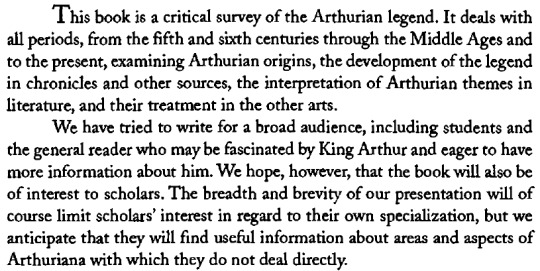
Encyclopedias & Handbooks
The Arthurian Companion by Phyllis Ann Karr
The New Arthurian Encyclopedia by Norris J. Lacy
The Arthurian Handbook by Norris J. Lacy & Geoffrey Ashe
The Arthurian Name Dictionary by Christopher W. Bruce
The King Who Was and Will Be by Kevin Crossley-Holland
Warriors of Arthur by John Matthews, Bob Stewart, & Richard Hook
Essays & Guides
A Companion to Chrétien de Troyes edited by Joan Tasker & Norris J. Lacy
A Companion to Malory edited by Elizabeth Archibald
A Companion to The Lancelot-Grail Cycle edited by Carol Dover
A Companion to the Gawain-Poet edited by Derek Brewer
Arthur in Welsh Medieval Literature by O. J. Padel
Diu Crône and The Medieval Arthurian Cycle by Neil Thomas
Wirnt von Gravenberg's Wigalois: Intertextuality & Interpretation by Neil Thomas
The Legend of Sir Lancelot du Lac by Jessie Weston
The Legend of Sir Gawain by Jessie Weston
#arthuriana#arthurian legend#arthurian mythology#arthurian literature#king arthur#queen guinevere#sir gawain#sir lancelot#sir perceval#sir percival#sir galahad#sir tristan#queen isolde#history#resource#my post
1K notes
·
View notes
Text

How Hadrian’s Wall is Revealing a Hidden Side of Roman History
A party invitation. A broken flipflop. A wig. Letters of complaint about road conditions, and an urgent request for more beer.
It sounds like the aftermath of a successful spring break, but these items are nearly 2,000 years old.
They’re just some of the finds from Hadrian’s Wall – the 73-mile stone wall built as the northwestern boundary of the Roman Empire, sealing off Britannia (modern-day England and Wales) from Caledonia (essentially today’s Scotland).
While most of us think of Pompeii and Herculaneum if we’re thinking of everyday objects preserved from ancient Rome, this outpost in the wild north of the empire is home to some of the most extraordinary finds.
“It’s a very dramatic stamp on the countryside – there’s nothing more redolent of saying you’re entering the Roman empire than seeing that structure,” says Richard Abdy, lead curator of the British Museum’s current exhibition, Legion, which spotlights the everyday life of Roman soldiers, showcasing many finds from Hadrian’s Wall in the process. A tenth of the Roman army was based in Britain, and that makes the wall a great source of military material, he says.
But it’s not all about the soldiers, as excavations are showing.
A multicultural melting pot
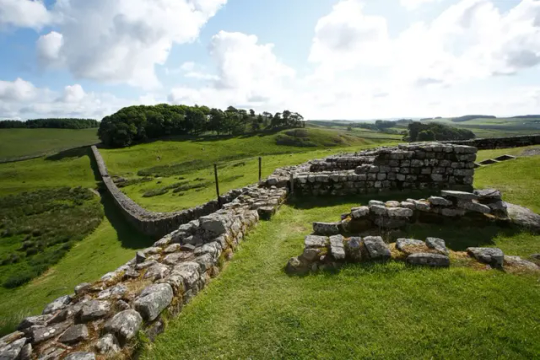
Hadrian, who ordered the wall to be built in 122CE after a visit to Britannia, had a different vision of empire than his predecessors, says Frances McIntosh, curator for English Heritage’s 34 sites along Hadrian’s Wall.
“All the emperors before him were about expanding the empire, but Hadrian was known as the consolidator,” she says. He relinquished some of the territory acquired by his predecessor Trajan, and “decided to set the borders” – literally, in some cases, with wooden poles at sites in Germany, or with stone in Britannia. Where those poles rotted thousands of years ago, the wall is still standing: “A great visual reminder” of the Roman empire, says McIntosh.
It’s not just a wall. There’s a castle every mile along, and turrets at every third-of-a-mile point, with ditches and banks both north and south. “You can imagine the kind of impact that would have had, not just on the landscape but on the people living in the area,” says McIntosh.
And thanks to the finds from the wall, we know a surprising amount about those people.
Although historians have long thought of army outposts as remote, male-dominant places, the excavations along the wall show that’s not the case. Not only were soldiers accompanied by their families, but civilians would settle around the settlements to do business. “ You can almost see Housesteads as a garrison town,” says McIntosh. “There were places you could go for a drink and so on.”
The Roman rule of thumb was not to post soldiers in the place they came from, because of the risk of rebellion. That meant Hadrian’s Wall was a cultural melting point, with cohorts from modern-day Netherlands, Spain, Romania, Algeria, Iraq, Syria – and more. “It was possibly more multicultural because it was a focus point,” says McIntosh, who says that the surrounding community might have included traders from across the empire.
Soldiers were split into two groups. Legionaries were Roman citizens from Italy, who had more rights than other soldiers and imported olive oil, wine and garum (a sauce made from decomposing fish).
They worked alongside auxiliaries – soldiers from conquered provinces, who had fewer rights, but could usually acquire citizenship after 25 years of service.
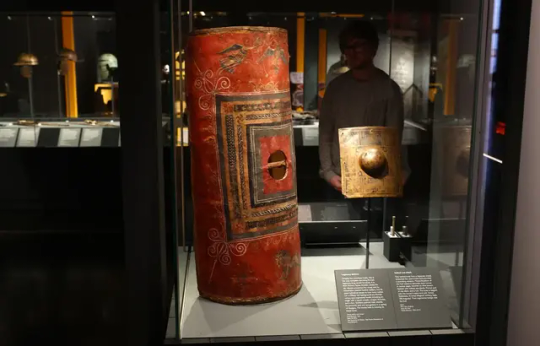
Soldiers carved their names and regiments on stones to show which part of the wall they built – around 50 of them are on display at Chesters fort.
But the wall shows that women and children were equally present.
McIntosh says that pottery brought to the camps – from the Low Countries and North Africa – shows that the soldiers “brought their families, who cooked in traditional style.” Archaeologists have found what seems to be an ancient tagine for North African-style cooking.
A tombstone from Arbeia fort for a woman named Regina shows she was a freed slave from southern Britain who was bought by – and married to – a Syrian soldier.
Another woman buried at Birdoswald fort was laid to rest with chainmail that appears to be from modern-day Poland. “Perhaps she married someone in the army,” says McIntosh, who calls the wall a “melting pot of people from all over the world under the banner of the army.”
“They brought their own religions, as well as worshipping Roman gods and adopting local deities,” she adds. At Carrawburgh, a temple to Mithras – an originally Persian deity – sat near a spring with a shrine to a local water spirit.
‘Wretched little Brits’

Some of the most extraordinary finds from the Roman empire are coming from one site on Hadrian’s Wall: Vindolanda. Here, archaeologists have found a wealth of organic remains because of what curator Barbara Birley calls the “unusual conditions onsite.”
At Vindolanda there are the remains of at least nine forts over 14 levels. “When the Romans would leave, they would knock down timber forts, and cover the area with turf and clay, sealing the layers underneath,” she says.
“Because it happened so many times, the bottom five or six layers are sealed in anaerobic conditions, so things don’t decay. When we get down there, we get wooden objects, textiles, anything organic.”
Vindolanda has the largest collection of Roman textiles from a single site in western Europe, as well as the largest leather collection of any site in the Roman empire – including 5,000 shoes, and even a broken leather flip-flop. “We probably had a population of 3,000 to 6,000 depending on the period, so 5,000 is a lot,” says Birley. For Abdy, the shoes evoke the conditions of the wet borderlands. “Women’s and children’s shoes are hobnailed – you needed it in the mucky frontier dirt tracks. They’re very evocative.”
There’s even a wig made from a local plant, hair moss, which is said to repel midges – the scourge of Scotland during the summer. A centurion’s helmet is also crested with hairmoss – the ancient equivalent of spraying yourself with insect repellent.
The first woman to write in Latin
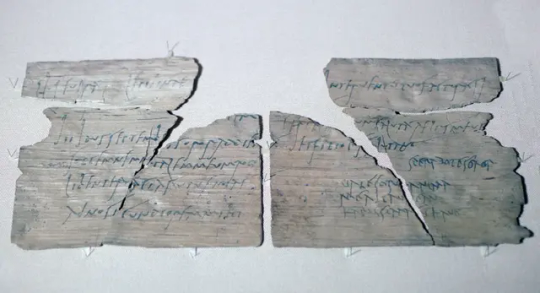
One of the most famous finds is the trove of wooden writing tablets – the largest found anywhere.
“They give a snapshot of what life was actually like,” says Birley. “We understand so much more from written correspondence than from ‘stuff,’ and, archaeologically, it’s the stuff that usually survives – things like metals and ceramics.
“These were written in ink, not on a wax stylus tablet, and we believe they were used for what we’d put in emails: ‘The roads are awful,’ ‘The soldiers need more beer.’ Everyday business.”
The tablets – or “personal letters” as Birley describes them – were found on the site of a bonfire when the ninth cohort of Batavians (in the modern-day Netherlands) were told to move on.
“They had a huge bonfire and lots of letters were chucked in the fire. Some have been singed – we think it may have rained,” she says. One of them calls the locals “Britunculi” – “wretched little Brits.” Another talks about an outbreak of pinkeye. One claims that the roads are too bad to send wagons; another laments that the soldiers have run out of beer.

Among the 1,700 letters are 20 that mention a woman called Sulpicia Lepidina. She was the wife of the commander of the garrison, and seems to have played a crucial role. There’s a letter to her from another woman, Paterna, agreeing to send her two medicines, one a fever cure.
Birley says it’s similar to today. “If you’re a group of moms, still today we say, ‘Do you have the Calpol?’ It’s very human.” For Abdy, it’s a sign that women were traders. “She’s clearly flogging her medicines,” he says. “It’s really great stuff.”
Another tablet is an invite from Claudia Severa, the wife of another commander at a nearby camp. It’s an invitation to a birthday party. Under the formal invitation, presumably written by a scribe, is a scrawl in another hand: “I shall expect you, sister. Farewell, sister, my dearest soul.”
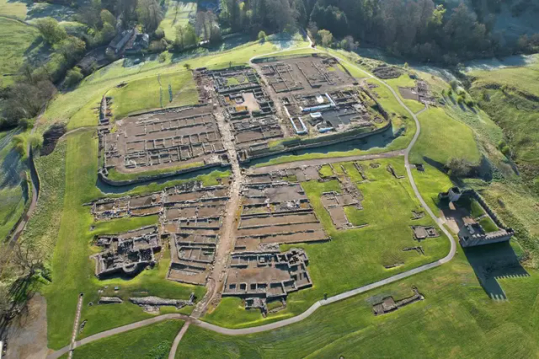
Presumably written by Claudia herself, it is thought to be the earliest example of a woman’s handwriting in Latin.
Without the organic finds – the shoes and the letters that indisputably belonged to women, unlike jewellery or weaving equipment – it’s difficult to prove conclusively that women lived in significant numbers. Vindolanda “illustrate the missing gaps,” says Abdy. For Birley, they prove that women were as crucial a part of army communities as men. “Before the Lepidina tablets were found we didn’t really understand the interactions between the soldiers and their wives,” she says. Another tablet is written by what is thought to be a Spanish standard-bearer’s common-law wife, ordering military equipment for her partner.
“The Vindolanda collection is showing that there weren’t just camp followers and prostitutes; women were part of everyday life, and contributing to the military community in many ways,” says Birley.
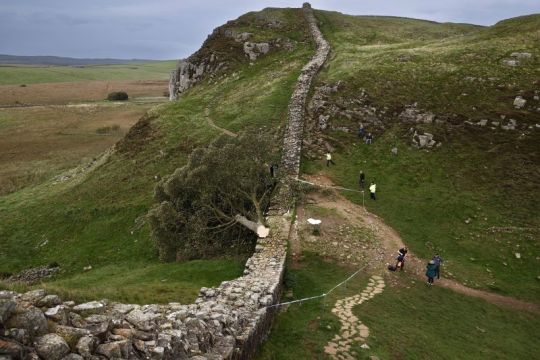

Abdy says that Hadrian’s Wall is interesting because the resident women span “all classes of society,” from Regina – the dead freedwoman, who would have been “bottom of the heap” – to the trader Paterna and the noblewoman Lepidina.
And of course, there’s the wall itself.
“In the Netherlands and Germany the finds are often stunning and better preserved – you go to museums and are bowled over. But in terms of structural remains, Hadrian’s Wall must be among the best,” says McIntosh, modestly, of her site.
Abdy agrees: “I can’t think of many symbols so redolent of imperial will than that wall.”
By Julia Buckley.
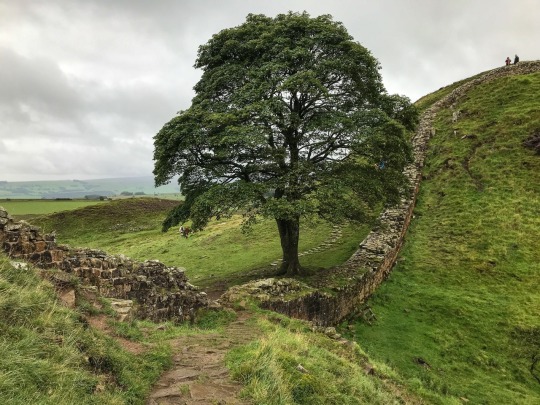
#How Hadrian’s Wall is Revealing a Hidden Side of Roman History#Hadrian’s Wall#emperor hadrian#northwestern boundary of the Roman Empire#Britannia#Caledonia#roman legions#ancient artifacts#archeology#archeolgst#history#history news#ancient history#ancient culture#ancient civilizations#roman history#roman empire#long post#long reads
918 notes
·
View notes
Text
Magic Is Masculinity: Or, Lucius Malfoy and How the Wand Makes the Man
One thing I'm always interested in thinking about in HP fic is how to realistically create a society with different mores from our own. If you take the premise that pureblood especially and overall wizarding culture more broadly is different from 1990s Muggle British society seriously, you must consider where social norms differ from 90s muggle norms. I personally am interested in the idea that pureblood families tend to live in multi-generational households with extended families rather than in a nuclear family, for instance, though I don't think this was JKR's intention (but who cares it's interesting). You could claim that LGBTQ+ people are more or less accepted than 90s Britain, depending on what you want to do with your story--and you could also consider that the wizarding world might have completely different definitions of sexuality (like, for example, the Roman use of penetrator vs non-penetrator as the main sexual binary). And we know that what is defined as masculinity and femininity varies massively across time and place.
So I want to think about how gender roles might differ in the wizarding world. There was a post I saw recently that discussed the idea of Sirius feeling affirmed in exploring femininity by being seen as feminine by Muggles while wearing robes, which I thought was a really interesting idea (and one that could apply to any character exploring gender). Of course the essential premise there is that something Muggles read as feminine--robes--are actually an essential aspect of Wizarding masculinity (see that guy who likes a nice healthy breeze round his privates in GoF).
So what else defines Wizarding masculinity? We can go absolutely wild! But I think there's a lot of canonical basis for the idea that one essential part of being a wizard and a man is having access to and control over one's own wand. This raises interesting questions about how characters who can't control their wands might be seen as emasculated (like Ron in CoS and Neville pre-HBP), and is also significant with regards to Voldemort's search for a wand that will allow him to fight Harry, and the period when Harry's wand is broken. So I'd love if people did additional analysis on this topic. But I'm going to specifically discuss the case of Lucius Malfoy, because I think he's a very clear example of how you need to have a wand to be a man.
"The faces around him displayed nothing but shock; he might have announced that he wanted to borrow one of their arms. “No volunteers?” said Voldemort. “Let’s see . . . Lucius, I see no reason for you to have a wand anymore.” Lucius Malfoy looked up. His skin appeared yellowish and waxy in the firelight, and his eyes were sunken and shadowed. When he spoke, his voice was hoarse. “My Lord?” “Your wand, Lucius. I require your wand.” “I . . .” Malfoy glanced sideways at his wife. She was staring straight ahead, quite as pale as he was, her long blonde hair hanging down her back, but beneath the table her slim fingers closed briefly on his wrist. At her touch, Malfoy put his hand into his robes, withdrew a wand, and passed it along to Voldemort, who held it up in front of his red eyes, examining it closely. “What is it?” “Elm, my Lord,” whispered Malfoy. “And the core?” “Dragon — dragon heartstring.” “Good,” said Voldemort. He drew out his own wand and compared the lengths. Lucius Malfoy made an involuntary movement; for a fraction of a second, it seemed he expected to receive Voldemort’s wand in exchange for his own. The gesture was not missed by Voldemort, whose eyes widened maliciously. “Give you my wand, Lucius? My wand?” Some of the throng sniggered. “I have given you your liberty, Lucius, is that not enough for you? But I have noticed that you and your family seem less than happy of late. . . . What is it about my presence in your home that displeases you, Lucius?” “Nothing — nothing, my Lord!” “Such lies, Lucius . . .” (Chapter 1, DH)
Having a wand is compared to having an arm: it's an essential part of a wizard's body. All the Death Eaters are shocked by the request. (Interestingly, we know of only two confirmed female Death Eaters, Bellatrix and Alecto Carrow. Bellatrix says that she would gladly give up any SONS specifically to the Dark Lord's service in HBP. This might imply that the Death Eaters are intended to be a majority male organization (though I personally like to explore the idea of there being more female Death Eaters) and so these are men specifically being affronted).
Before his wand is taken, it is specifically mentioned that Lucius appears ill--pale and waxen and yellow. Control of the body and good health is often seen as a crucial sign of masculinity. Lucius has lost this--he cannot control his own body--and is about to lose an important signal of his masculinity, his wand.
Voldemort is also treating Lucius as a child who's transgressed: there is 'no reason for him to have a wand anymore'--Voldemort doesn't respect Lucius's right to have a wand, like he's a child who isn't in control of his own decisions. A main throughline of Lucius's treatment since OOTP is Voldemort's interest in punishing him. This involves reducing him to a child to be ordered around, who can't be trusted with a wand. He treats Lucius as someone deeply beholden to him: Lucius having a wand and having liberty are dependent on Voldemort, instead of characteristics of an adult man with social authority. Voldemort is the patriarch of the Death Eater family.
Voldemort seems to enjoy humiliating him in front of the other Death Eaters: he could have asked him nicely as an equal in private, but he makes a spectacle of it, asking for volunteers he knows won't be appearing, only to single out Lucius and then mock any pretensions he might have to exchanging wands, then intimidating and terrifying him by questioning his loyalty (and the loyalty of his family, which thus insults Lucius's ability as a patriarch). The wand length comparison also serves no real purpose but to emasculate Lucius.
Immediately after taking the wand, Vodlemort also brings up Tonks's marriage to Remus to insult Lucius, Narcissa, and Bellatrix--another insult to Lucius's abilities as a patriarch as he cannot stop his family members from shaming the family through marriage choices. Again, it is delberate that Voldemort does this so soon after taking Lucius's wand. Now that Lucius is wandless, his masculine authority can be questioned.
Lucius clearly wants later to reclaim this lost authority --and implicitly his sense of his own masculinity.
When the Trio is captured, Lucius is extremely excited. He appears to be motivated by a desire to lessen his punishment (which involved Voldemort taking his wand, and said wand being destroyed by Harry):
"Harry had never heard Lucius Malfoy so excited. “Draco, if we are the ones who hand Potter over to the Dark Lord, everything will be forgiv —” “Now, we won’t be forgetting who actually caught him, I hope, Mr. Malfoy?” said Greyback menacingly." (DH)
Greyback says 'Mr. Malfoy' in a menacing way: it seems to be belittling him, reminding him that he doesn't actually have that much power in this scene compared to Greyback, who actually captured them by his own efforts compared to Lucius passively waiting for something to improve his situation. Greyback may be saying 'Mr. Malfoy' to say: all you have is your social position, compared to me--you might have the title of 'mr' but you don't have a wand and you don't have the power to act, so I am more masculine and can threaten you.
It's also really interesting how Narcissa is directing Lucius and Draco in this scene: she greets Greyback and brings him in, she refers to Draco as her son only, she is the first one to instruct Draco to examine them. Malfoy Manor might be Lucius's home, it has his name, but Narcissa appears to act as patriarch in this scene: it's her home, her son, she is greeting visitors and taking command, and she is the one to say 'we need to be sure and shouldn't immediately summon Voldemort' and the one to identify Hermione. This might be the typical Malfoy family dynamic, it might be because Narcissa is the one who still has a wand.
Then Bellatrix comes in, and she orders both Lucius and Narcissa around. She also asks Narcissa what happened, treating her as the leader of the family. Now Bellatrix has always hated Lucius, they certainly didn't seem to get along well during the DoM battle. But here she's just contemptuous of him, and provides key evidence for my wand-equals-masculinity theory.
"“I was about to call him!” said Lucius, and his hand actually closed upon Bellatrix’s wrist, preventing her from touching the Mark. “I shall summon him, Bella, Potter has been brought to my house, and it is therefore upon my authority —” “Your authority!” she sneered, attempting to wrench her hand from his grasp. “You lost your authority when you lost your wand, Lucius! How dare you! Take your hands off me!” “This is nothing to do with you, you did not capture the boy —” " (DH)
Lucius lost his authority when he lost his wand. He is no longer the patriarch, the master of the house, specifically because he does not have a wand: Bellatrix then goes on to order Draco around, which Narcissa protests because it's 'her house': a striking contrast to Voldemort calling it Lucius's house in the first chapter, before he took the wand, and to Lucius trying to call it his house. While Lucius has a wand it's his house, but when his is taken it become's Narcissa's (though of course she is talking to her sister about herself, so you don't necessarily have to read that much into it). Interestingly, Bellatrix doesn't give orders to Lucius: maybe because she just doesn't like or trust him but maybe because he doesn't have a wand and is thus useless.
The whole concept of authority in HP--and Lucius, owner of Malfoy Manor, husband and father, has specifically patriarchal authority as Head of his family--is linked to having a wand. Lucius seems to have expected to be able to exercise some control over Bellatrix as a fellow Death Eater and as his sister-in-law who appears to be living with him, but she rejects this possibility by saying he can't control her as a male patriarch might because he doesn't have a wand. Thus he is failing to meet the requirements of being a patriarch in wizarding society. Bellatrix can do whatever she wants in his house, and he has no way of stopping her. She seems to have replaced him as patriarch of the Malfoy family.
The linkage of masculinity with authority with having a wand is made extremely clear through Bellatrix's line. By taking Lucius's wand, Voldemort removed the last semblance of authority and masculinity he had, to humiliate and emasculate him for losing the diary and the prophecy (and I think the broader narrative is doing this to Lucius at least a little as well, he becomes more pathetic and pitiable, because in JKR's view of gender pity is for women).
Later, Lucius's role as a Death Eater has clearly been reduced: Voldemort dismisses his suggestions around the Battle of Hogwarts as only being concerned for his son, and assigns him the menial task of fetching Snape. He has been reduced from advisor to fetch-and-carrier. Lucius's last appearance on page is NOT fighting in the Battle of Hogwarts, appearing only concerned with his son (and JKR often associates concern with a child only over any other concerns with maternity and femininity, but that's another post).
In working on this meta I also had a lot of thoughts about warrior masculinity through martial magic in the Wizarding World, and the idea of a Death Eater specific masculine warrior ideal, but that's another post LMAO. I hope this has been helpful in imagining how magic might affect gender roles!
#masculinity in hp#gender in hp#hp world#hp worldbuilding#worldbuilding in hp#Lucius malfoy#wands#wand#hp#hp meta#my hp meta#harry potter#death eaters#death eaters meta#voldemort#second war with voldemort#Malfoy manor#Bellatrix lestrange#narcissa black#narcissa malfoy
181 notes
·
View notes